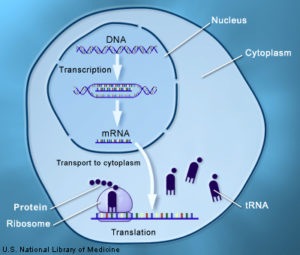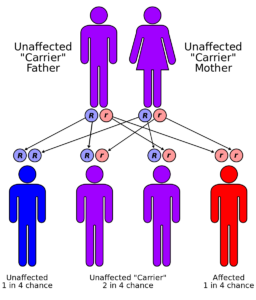50 How Mutations Occur
A gene mutation is a permanent alteration in the DNA sequence that makes up a gene, such that the sequence differs from what is found in most people. Mutations range in size; they can affect anywhere from a single DNA building block (base pair) to a large segment of a chromosome that includes multiple genes.
Recall that the DNA sequence found within a gene controls protein synthesis. If the DNA sequence is altered, this can alter the amino acid sequence within a protein. If the amino acid sequence within a protein is changed, this can change the shape of the protein and therefore its function.

Gene mutations can be classified in two major ways:
- Hereditary mutations are inherited from a parent and are present throughout a person’s life in virtually every cell in the body. These mutations are also called germline mutations because they are present in the parent’s egg or sperm cells, which are also called germ cells. When an egg and a sperm cell unite, the resulting fertilized egg cell receives DNA from both parents. If this DNA has a mutation, the child that grows from the fertilized egg will have the mutation in each of his or her cells.
- Acquired (or somatic) mutations occur at some time during a person’s life and are present only in certain cells, not in every cell in the body. These changes can be caused by environmental factors such as ultraviolet radiation from the sun, or can occur if a mistake is made as DNA copies itself during cell division. Acquired mutations in somatic cells (cells other than sperm and egg cells) cannot be passed on to the next generation.

Genetic changes that are described as de novo (new) mutations can be either hereditary or somatic. In some cases, the mutation occurs in a person’s egg or sperm cell but is not present in any of the person’s other cells. In other cases, the mutation occurs in the fertilized egg shortly after the egg and sperm cells unite. It is often impossible to tell exactly when a de novo mutation happened. As the fertilized egg divides, each resulting cell in the growing embryo will have the mutation. De novo mutations may explain genetic disorders in which an affected child has a mutation in every cell in the body but the parents do not, and there is no family history of the disorder.
Somatic mutations that happen in a single cell early in embryonic development can lead to a situation called mosaicism. These genetic changes are not present in a parent’s egg or sperm cells, or in the fertilized egg, but happen a bit later when the embryo includes several cells. As all the cells divide during growth and development, cells that arise from the cell with the altered gene will have the mutation, while other cells will not. Depending on the mutation and how many cells are affected, mosaicism may or may not cause health problems.
Most disease-causing gene mutations are uncommon in the general population. However, other genetic changes occur more frequently. Genetic alterations that occur in more than 1 percent of the population are called polymorphisms. They are common enough to be considered a normal variation in the DNA. Polymorphisms are responsible for many of the normal differences between people such as eye color, hair color, and blood type. Although many polymorphisms have no negative effects on a person’s health, some of these variations may influence the risk of developing certain disorders.
References
“Mutations and Health” by U.S. National Library of Medicine is in the Public Domain

